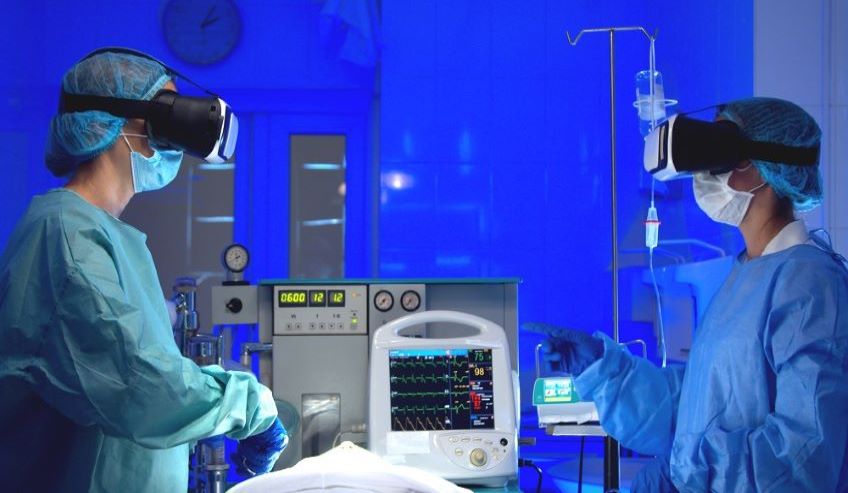
The Glue Talk Blog

Virtual reality (VR) and augmented reality (AR) are more than simply emerging technologies — they’re a shift in the way people learn, work, and play. Students and military service members train in interactive simulations, surgeons perform operations remotely, and gamers immerse themselves in worlds only these new technologies can provide. Essentially, VR and AR technologies can fill in the gaps to support those in industries wherever there are limitations in real-world experience or offer the possibility to explore new worlds entirely.
Emerging Technologies Bring Opportunities
The market for VR and AR equipment expands rapidly each year. Statista reports that the market for these emerging technologies will reach 18.8 billion U.S. dollars in 2020 alone — a 78 percent increase from 2019. Further, in 2020, sales of VR and AR headsets are predicted to reach 5.5 million units, purchased by everyone from ordinary consumers to professionals in the healthcare and aerospace industries.
Gaining Followers
The VR and AR hardware market’s potential for growth has seized the attention of social media platforms like Facebook and Snapchat, who have been quick to take advantage of the sales boom. Facebook has even designed its own VR headset, Oculus, and people on social media have adopted the technology to create unique videos, adding a 360-degree immersive world to the stories they share and the way their followers engage with content.
Next Generation Gaming
AR and VR’s presence in the digital sphere naturally includes the video gaming industry: The primary driver for the newest virtual technology. Games are beginning to proliferate, but depending on the platform on which gamers play, costs can vary. PlayStation’s PSVR demonstrates what a powerful experience gaming in a 360-degree environment can be with a reasonable price tag. Other AR and VR equipment requires more investment, but the landscape of developing games for PC that use AR and VR headsets continues to broaden the possibilities and features of the next generation gaming experience.
Cutting-Edge Medicine
VR medical training provides a useful simulation, letting workers in the healthcare industry make their first steps in applying knowledge before entering real-world practice. Virtual environments help medical students see their subjects up close and in a way previously impossible. Three dimensional models of organs are brought to life for students to examine from all angles, while VR also lets doctors practice a procedure virtually before attempting it in real life.
Creating Optimal Devices
To push the boundaries of technology, precision instruments need to perform optimally. Lightweight AR and VR headsets help create a more immersive experience by removing the sense of wearing a heavier device, and the user can experience eyestrain or headache without smaller, lighter, and more compact optical pieces. Mechanical fasteners increase both the weight and size of VR and AR technologies, but weight reducing, high-efficiency adhesives can help solve challenges in building cost effective and high-performing hardware.
VR and AR Solutions from H.B. Fuller
At H.B. Fuller, our adhesives provide solutions to companies looking to make AR and VR equipment that is more affordable and that improves the user’s experience. Adhesives offer a reliable way to reduce the size and weight of these devices, as well as opening the door for improvements in optical design.
Contact us to learn more about how we help our customers build better devices through premier adhesive solutions.
Blog Categories
Blog Categories
Archive
- 2024
- 2023
- 2022
-
2021
- January (3)
-
February (7)
- Celebrating Exceptional Service During COVID-19 Complications
- Cyanoacrylates: What They Are and What They Do
- Innovative two-shot bookbinding adhesive
- Make a Difference 2020
- Problem Solving: Paper Straws in Drinking Beverages
- Stronger straws sustainable future
- Substances of Interest in Disposable Absorbent Hygiene Products
- March (4)
- April (4)
- May (4)
- June (5)
- July (2)
- August (5)
- September (2)
- October (1)
- November (3)
- December (2)
-
2020
- January (4)
- February (2)
- March (3)
- April (4)
- May (3)
-
June (7)
- Community Support in the Era of Coronavirus
- HBFuller Employee Creates Face Shields with 3D Printer
- Improved Packaging Integrity and Greater Customer Satisfaction
- Liquid-Resistant Paper Straws
- What is a Sealant?
- What Is the Future of Commercial Disinfectants?
- Winning over consumers with e-commerce packaging solutions
-
July (6)
- Employees Take Action to be Part of Healing and Growth
- Gain a competitive advantage with packaging adhesive solutions
- HB Fuller Company Foundations Commitment to Communities
- Packaging Solutions for the South African Agriculture Market
- Supporting Organizations That Provide STEM Education for Youth
- Where Does Sustainability Stand Amid COVID-19
- August (3)
- September (2)
- October (4)
- November (2)
- December (4)
